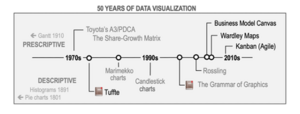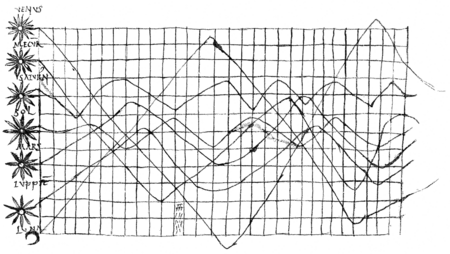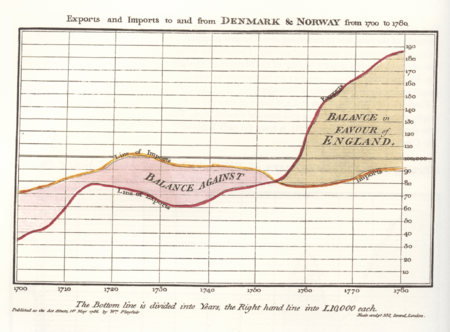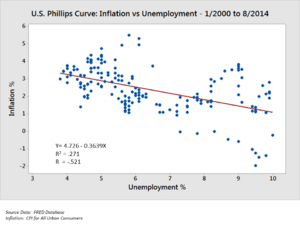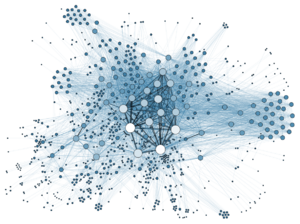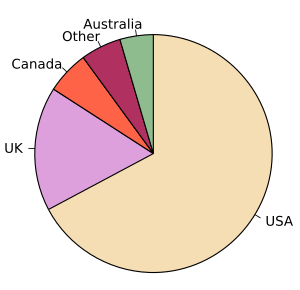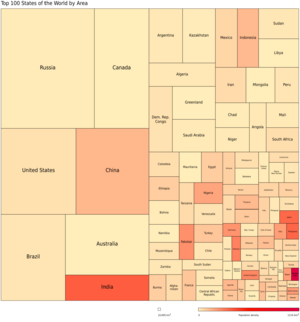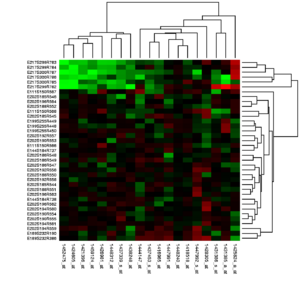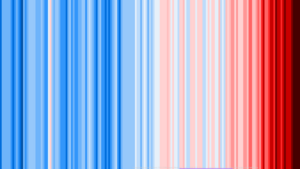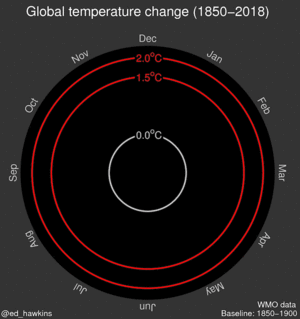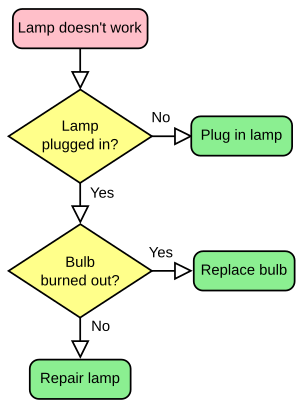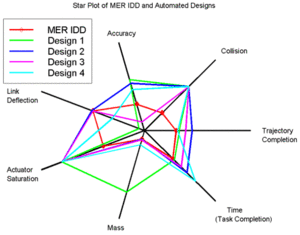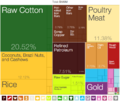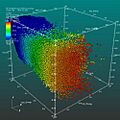Data and information visualization facts for kids
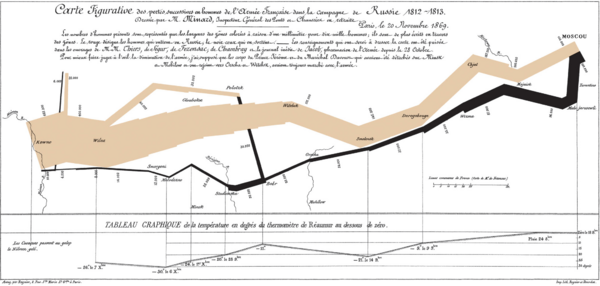
Data and information visualization (or just data viz and info viz) is about turning lots of complicated numbers and facts into easy-to-understand pictures. Think of it like drawing a map to help you find your way through a huge pile of information!
This helps people see important things like patterns, trends, and connections that would be hard to spot in plain text or numbers. When these visuals are made for everyone to understand a specific message, they are often called information graphics.
Data visualization usually focuses on showing numbers and measurements. It uses pictures like tables, charts, and graphs. Some common types are:
- pie charts
- bar charts
- line charts
- area charts
- histograms
- funnel charts
- heat maps
Information visualization works with bigger, more complex sets of information. This can include numbers, but also non-numerical things like words or ideas. Its main goal is to make raw information more valuable and help people understand it better. It also helps them make smart choices as they look at and use computer-made visuals. Tools for information visualization include:
- maps (like tree maps)
- animations
- infographics
- flow charts
- network diagrams
- venn diagrams
- timelines
New technologies like virtual reality (VR) and augmented reality (AR) are making these visuals even more exciting. They can make information feel more real, easier to use, and more fun to explore. This helps your brain understand things even faster!
Contents
Why Visualizing Data is Important
Good data visualization is clear, simple, and easy to understand. It uses accurate and up-to-date information so you can trust what you see. The pictures, colors, and shapes are chosen carefully to make sense and look good without being distracting.
Visuals often come with words, like labels and titles. These words and pictures work together to help you learn quickly and remember what you saw. Great visuals also think about who will be looking at them. They guide people to the main ideas.
Visualizing data helps many different people:
- It can explain big, complex ideas to people who aren't experts.
- It helps experts and leaders make important decisions.
- It helps scientists find errors or missing parts in data.
- In business, it can be part of "data storytelling." This means using visuals with a story to explain data and convince people to take action.
This field combines ideas from many areas. These include descriptive statistics (which started long ago), visual communication, graphic design, and how our brains work (cognitive science). Because it needs skills in design, math, and computers, some people say it's both an art and a science!
Scientists also study how people look at and sometimes misunderstand visuals. This helps them create better charts and graphs that truly share information. But watch out! Bad or tricky visuals can sometimes spread wrong information or try to change what people think.
A Brief History of Data Visualization
People have been visualizing data for a very long time! Even in prehistoric times, people drew pictures of stars on cave walls. Ancient objects like clay tokens and Inca quipus also showed numbers and information.
The first known data visualization is the Turin Papyrus Map from 1160 B.C. It showed where rocks and minerals were located. Maps that show specific information about a place, like this one, are called thematic maps.
Ancient Egyptians used ideas like coordinates to plan towns. The Greek scholar Claudius Ptolemy created maps using latitude and longitude around 200 BC. These ideas were used for over a thousand years!
The invention of paper helped visuals grow. In the 10th or 11th century, someone drew a graph of how planets move. It showed how far planets were from a central line over time.
By the 16th century, people got much better at measuring things accurately. This helped create more precise maps and charts. Later, mathematicians like René Descartes developed the X-Y coordinate system we use today. This made it much easier to draw graphs of numbers.
In the late 1700s, William Playfair published the first modern charts, like bar charts and line graphs. He saw how powerful pictures could be for sharing numbers.
In recent times, computers have changed everything! Now, we can create amazing interactive visualizations. Programs like R and Python help people make all kinds of data visuals. There are even special schools and programs to teach people these skills.
Types of Visualizations
Different types of charts and graphs are best for showing different kinds of information. Here are some common ones:
| Name | What it shows | How it works and when to use it | |
|---|---|---|---|
| Bar chart | Length/count, category, color | Uses rectangular bars to show amounts. The taller or longer the bar, the bigger the value. Great for comparing different groups, like sales for different products. | |
| Histogram | Bin limits, count/length, color | Shows how often different values appear in a set of numbers. Imagine you have a list of house prices. A histogram groups them into price ranges (like $100k-$200k, $201k-$300k) and shows how many houses fall into each range. | |
| Scatter plot | X position, Y position, symbol, color, size | Uses dots to show the relationship between two different things. Each dot is one piece of data. For example, you could plot how much time someone studies (X) and their test score (Y) to see if there's a connection. | |
| Network | Node size/color, tie thickness/color, spatialization | Shows how different things are connected. Think of a social media network: dots are people, and lines are friendships. It helps find groups or important connections. | |
| Pie chart | Color | A circle divided into slices. Each slice shows a part of a whole, like how much of a pizza each person ate. Good for showing percentages. | |
| Line chart | X position, Y position, symbol, color, size | Connects data points with lines. It's perfect for showing how something changes over time, like temperature each day of the week. | |
| Treemap | Size, color | Shows data in nested rectangles. The size of each rectangle shows its value. Useful for seeing how different parts make up a whole, like disk space used by different file types. | |
| Gantt chart | Color, time (flow) | A special bar chart that helps plan projects. It shows tasks and when they need to be done. | |
| Heat map | Color, categorical variable | Uses colors to show the strength of something in two dimensions. For example, a map of a city where warmer colors show areas with more people. | |
| Stripe graphic | X position, color | A simple way to show trends, often used for climate change. Each stripe is a year, and its color shows how warm or cold that year was. | |
| Animated spiral graphic | Radial distance, rotating angle, color | Shows how a single thing changes over time in a spiral shape. Often used to show global temperatures changing over many years. | |
| Box and Whisker Plot | X axis, Y axis | Shows how a group of numbers is spread out. It highlights the middle value, the spread of the data, and any unusual values (outliers). Good for comparing different groups, like the ages of boys versus girls. | |
| Flowchart | Workflow or process | Uses boxes and arrows to show the steps in a process or how to solve a problem. Like a recipe, but for actions! | |
| Radar chart | Attributes, value assigned to attributes | Shows several different qualities for one item, or compares several items based on those qualities. Imagine comparing different video games based on graphics, story, and gameplay. | |
| Venn diagram | Logical relations between sets | Uses overlapping circles to show how different groups (sets) share things. The overlapping part shows what they have in common. |
Other Visual Techniques
There are many other ways to visualize data, including:
- Cartograms (maps where areas are changed to show data)
- Concept Mapping (showing ideas and how they connect)
- Dendrograms (tree-like diagrams for classification)
- Parallel coordinates (showing many variables at once)
Making Visuals Interactive
Interactive data visualization means you can do things with the picture, like click on parts of it to see more details or change how it looks.
Common ways to interact include:
- Brushing: Using your mouse to highlight parts of a graph. If you have several graphs open, highlighting something in one might highlight the same data in another.
- Painting: Like brushing, but the highlights stay even after you move your mouse. This is useful for grouping data points.
- Identification: When you move your mouse over a point or bar, a label pops up to tell you what it is.
- Zooming and Scaling: Changing the view to look closer at a small area or to see the whole picture differently.
- Linking: Connecting different graphs so that when you select something in one, the related parts light up in all the others.
How We Use Data Visualization Today
Data and information visualization helps in many areas, such as:
- Scientific research
- Data mining (finding patterns in huge datasets)
- Analyzing money and investments
- Health care
- Studying markets (like what people buy)
- Crime mapping (showing where crimes happen)
- Understanding how governments work
Images for kids
-
A data visualization of a social media network.


